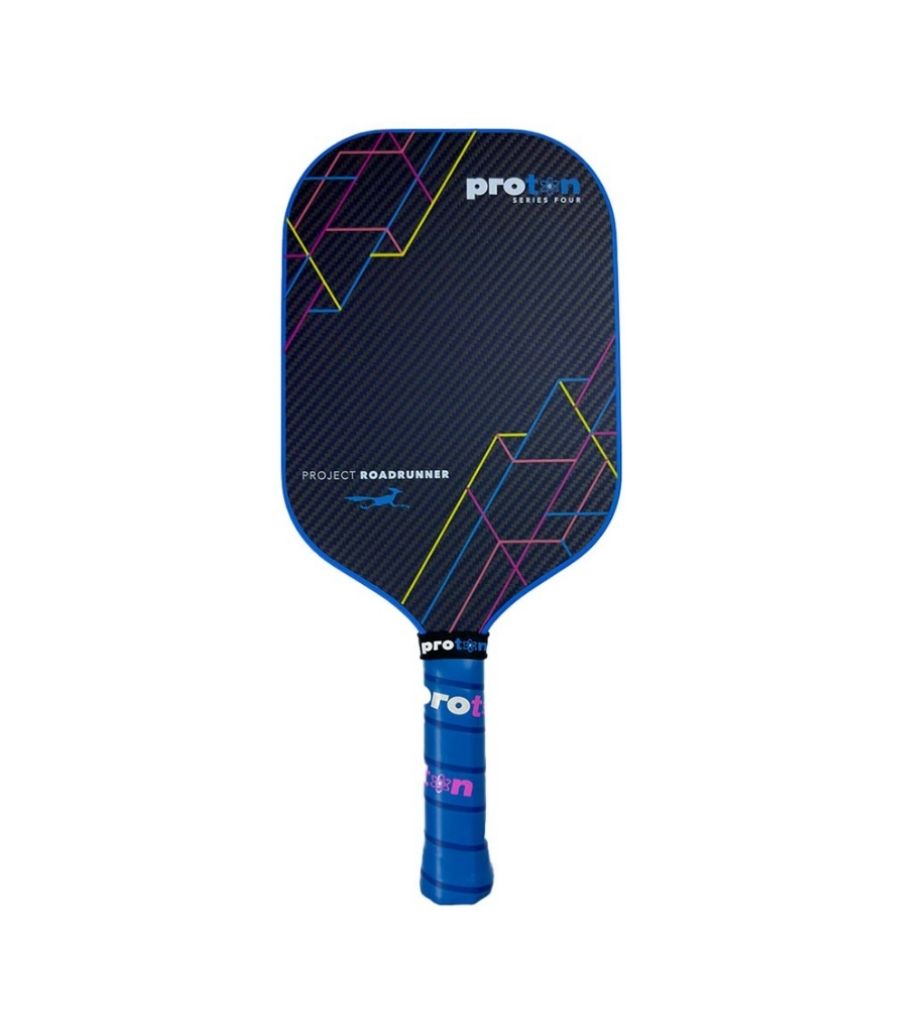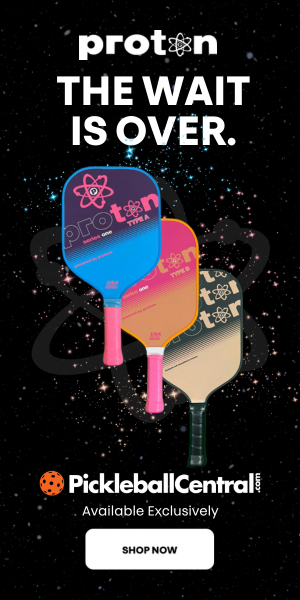Expert review: Proton Series Four combines plush feel with pop when you need it
Last Edited
Feb 13 2025
Category
Gear
Although Proton is still considered a fairly new company in pickleball – they broke into the industry in 2024 – by now you’ve probably played with or encountered one of their eye-catching paddles at your local courts.
There’s a reason for that: They’ve combined innovative paddle technology with bold designs with each release, standing out in a sea of black carbon fiber paddles that have flooded the market since the early 2020s.
One of their best-looking paddles, the Series Four - Project Roadrunner, was released in the fall of 2024 and packed tons of new tech into a sleek, edgeless design.
With this release, Proton introduced a hybrid core that included a layer of Nomex (typically associated with more poppy paddles) sandwiched between two layers of traditional polypropylene. The result is a plush feel that was quite comfortable on drops, resets and dinks. But the Nomex layer in the core comes into play on drives and counters, providing an extra boost when you need it. Meanwhile, the high-quality carbon fiber face with exposed Kevlar fibers gives the paddle a very gritty hitting surface that won’t wear down as fast as traditional carbon fiber paddles, according to Brant Weiss, the vice president of pickleball at Proton.
Meanwhile, the high-quality carbon fiber face with exposed Kevlar fibers gives the paddle a very gritty hitting surface that won’t wear down as fast as traditional carbon fiber paddles, according to Brant Weiss, the vice president of pickleball at Proton.
As with all of my paddle reviews, I tested this paddle for several hours with drills from the baseline, in the transition zone and at the kitchen line. I’ve detailed my thoughts on how the paddle performs in each of those areas below.
Let’s cook!
Proton Series Four - Project Roadrunner

Best suited for players who: Prefer to drop their third shot and look to be aggressive with flicks out of the air at the kitchen line. If you are somebody who is looking for more hand speed, this paddle’s lighter weight and edgeless design will help in that regard.
Key specs
Weight: 7.9 ounces
Swingweight: 116 (medium)
Twistweight: 5.7 (low)
Handle length: 5.375 inches
Paddle length: 16.5 inches
Paddle width: 7.375 inches
Paddle face: Aersospace grade bi-directional carbon fiber, exposed Kevlar weave
Core material: Polypropylene Nomex hybrid
Core thickness: 15mm
From the baseline
Quick hits:
- Very comfortable on third-shot drops.
- Gritty paddle face provides good spin on both drops and drives, as well as serves.
- I added weight to the sides of the paddle and top corners to get more power on third-shot drives and serves.
The full story:
I really liked the feel of the paddle on third-shot drops. I was able to get them to dip just the way I wanted and land in the kitchen without a lot of effort or adjustment time.
The Nomex/polypropelyne “sandwich” in the core gives this paddle almost two settings – on softer shots like drops and dinks, the ball isn’t sinking far enough into the face to reach the Nomex, so you get the softer “control” feeling of a traditional honeycomb paddle.
But when you really go after a serve or third-shot drive, you can feel the difference in the amount of time the ball stays on the paddle (which adds spin) and a noticeable increase in power from the Nomex coming into play.
I added .4 ounces of weighted tape to the sides and top corners of the paddle to give it more “plow-through” on drives and other full shots. I really like that this paddle starts out at a lighter weight because it offers more room for customization – players can get the weight exactly where they want it.
In transition
Quick hits:
- Paddle has a soft feel on resets and fifth-shot drops.
- High spin potential allows for more aggression and precision from this area.
- Adding weight to sides of paddle adds stability and helps on resets.
Like with third-shot drops from the baseline, fifth shots and resets from the transition zone felt very comfortable with this paddle.
I felt like I was able to be a little more aggressive and precise with spin and pace in the transition zone – whereas with most paddles, resets are more about hitting flat, slow shots. For that reason, I think this paddle would be well suited for players who like to take their time getting up to the kitchen line and use a third-shot drive/fifth-shot drop strategy to get into the point.
Because it has a relatively low twistweight and no edgeguard, the paddle can tend to twist in the hand if an opponent hits a particularly aggressive attack. But added weight to the sides of the paddle will help with that.
At the kitchen
Quick hits:
- Edgeless design = more hand speed.
- Easy to be aggressive on flicks out of the air, grit will add enough spin to keep those shots in.
- Plush feel on dinks.
I felt like the paddle really shined in this area of the court. It’s easy to control pace and spin on dinks because of its plush feel, while it has good pop in faster exchanges because of the Nomex layer in the core.
The edgeless design is a big plus in terms of hand speed and maneuverability, so you’re more likely to get the paddle where you need it in order to make good contact.
That’s also good for flicks out of the air and attacks off the bounce, which require a quick, whippy acceleration through the hitting zone. Combined with a rough surface that grips the ball and helps it stay in, those shots felt particularly good with this paddle.



